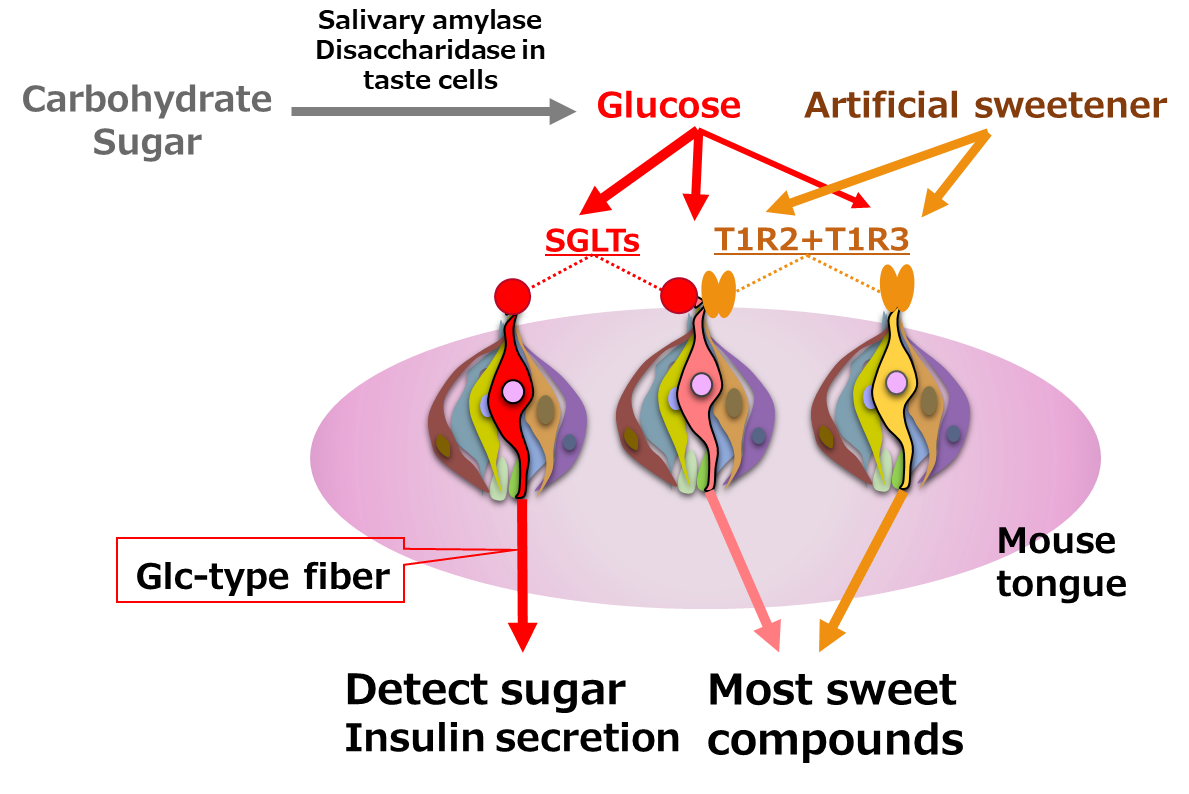研究成果 Research Results
- TOP
- News
- Research Results
- Sugar more than just sweet to the tongue
Sugar more than just sweet to the tongue
Identification of nerve fibers responding specifically to simple sugars helps explain why we can distinguish between artificial sweeteners and the real stuff 2020.10.06Research ResultsLife & Health

Carbohydrates and sugars are broken down by enzymes in the mouth into glucose. While taste cells only with traditional sweetness taste receptors (T1Rs; right) have trouble distinguishing artificial sweeteners from glucose, new evidence indicates there are also cells responding specifically to glucose via sodium-glucose cotransporters (SGLTs; left) and cells capable of both sensing mechanisms (middle).
Bread, rice, and potatoes are delicious enough to have every day, and recent collaborative research from Kyushu University may shed new light on why this is—and why artificial sweeteners just cannot beat the real thing.
Studying the tongues of mice, researchers led by Keiko Yasumatsu, professor at Tokyo Dental Junior College, and Yuzo Ninomiya, professor of Kyushu University’s Research and Development Center for Five-Sense Devices, report that, in addition to traditional taste receptors, cells able to take up the simple sugar glucose with the aid of sodium appear to play a role in sensing sweetness.
In our mouths, some of the carbohydrates in foods like grains and potatoes breakdown into sugars, and much of the sensing of these sugars has been attributed to a family of taste receptors known as T1R. However, evidence has been mounting that sugars in particular are also being sensed in other ways, with one candidate being cells that import glucose and sodium together through proteins in their membranes called sodium-glucose cotransporters.
To investigate the role of such cotransporters in tasting sweetness, the researchers recorded how nerves that carry taste signals to the brains of mice responded to different mixtures of sugars, sodium, and other molecules.
In a nerve called the chorda tympani, they found that about one-third of sweet-sensitive fibers exhibited a response to glucose without responding to an artificial sweetener and that the glucose response was enhanced by sodium chloride and suppressed by phlorizin, a chemical that blocks glucose from the sodium-glucose cotransporters.
Furthermore, they observed two other types of sweet-sensitive fibers: ones that were insensitive to phlorizin but responded to an artificial sweetener and ones that were affected by both phlorizin and the artificial sweetener. In mice genetically modified to lack a key sweetness taste receptor known as T1R3, the response to artificial sweeteners from cells insensitive to phlorozin disappeared.
Based on these observations, the researchers have identified three groups of neurons for tasting sweetness based on their sensing mechanisms: sodium-glucose cotransporters, taste receptors, or both. While taste receptors can be fooled by artificial sweeteners, cells sensitive primarily to glucose based on sodium-glucose cotransporters cannot, helping to explain the subtle difference in taste.
Biologically, this sensing mechanism may be playing a role in processes such as the release of insulin when sugars are tasted, which has been seen even in mice lacking the taste receptors for sweetness.
###
For more information about this research, see “Sodium-glucose cotransporter 1 as a sugar taste sensor in mouse tongue,” Keiko Yasumatsu, Tadahiro Ohkuri, Ryusuke Yoshida, Shusuke Iwata, Robert F. Margolskee, and Yuzo Ninomiya, Acta Physiologica (2020). https://doi.org/10.1111/apha.13529
Research-related inquiries
Yuzo Ninomiya, Research Professor
Division of Sensory Physiology • Medical Application Sensing, Research and Development Center for Five-Sense Devices
Keiko Yasumatsu, Professor
Tokyo Dental Junior College
Contact information can also be found in the full release.
- TOP
- News
- Research Results
- Sugar more than just sweet to the tongue































